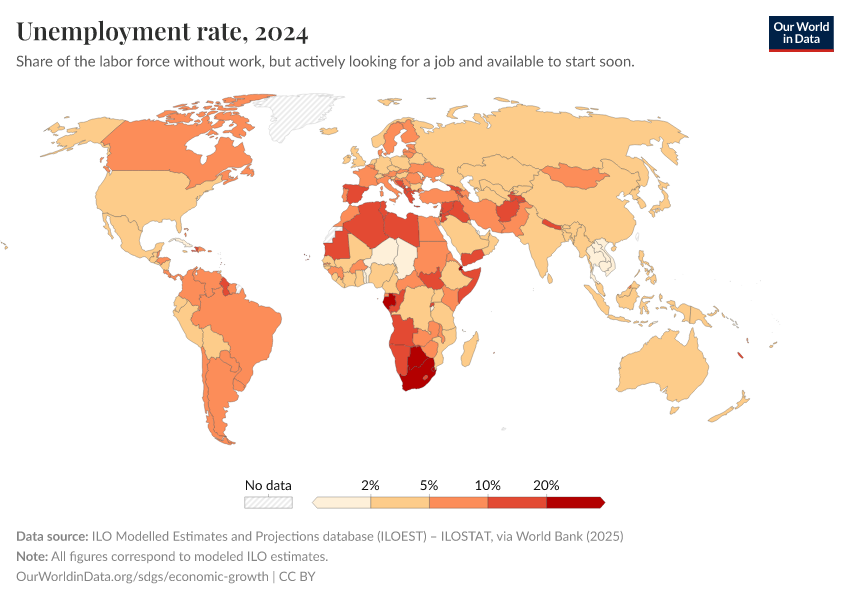Unemployment rate

What you should know about this indicator
- The unemployment rate measures the share of the labor force that is without a job but actively looking for work and available to start soon. It is one of the most widely used indicators of labor market conditions across countries and over time.
- When defining the labor force, the definition of “working age” varies across countries, depending on national laws and practices. In the ILO modeled estimates shown here, this is harmonized to refer to people aged 15 and older.
- This data comes from the ILO Modelled Estimates series. The ILO combines countries' own reported estimates with statistically modeled estimates when observations are missing. This ensures that the data follows harmonized definitions and is comparable across countries and over time. It also allows the ILO to calculate regional and global aggregates for every year. You can read more about how the ILO produces these estimates in the Modelled Estimates documentation.
- This data follows the standards of the 13th International Classification of Labour Statisticians (ICLS). One important point is that employment encompasses work for pay or profit, including self-employment, and also the production of goods for own use (such as subsistence farming). Changes in the definition of employment imply changes in the identification of the unemployed and of those out of the labor force. Because definitions changed under the 19th ICLS, data using those newer definitions are not fully comparable with data based on the 13th ICLS. You can read more about the definitions in this explainer by the ILO.
What you should know about this indicator
- The unemployment rate measures the share of the labor force that is without a job but actively looking for work and available to start soon. It is one of the most widely used indicators of labor market conditions across countries and over time.
- When defining the labor force, the definition of “working age” varies across countries, depending on national laws and practices. In the ILO modeled estimates shown here, this is harmonized to refer to people aged 15 and older.
- This data comes from the ILO Modelled Estimates series. The ILO combines countries' own reported estimates with statistically modeled estimates when observations are missing. This ensures that the data follows harmonized definitions and is comparable across countries and over time. It also allows the ILO to calculate regional and global aggregates for every year. You can read more about how the ILO produces these estimates in the Modelled Estimates documentation.
- This data follows the standards of the 13th International Classification of Labour Statisticians (ICLS). One important point is that employment encompasses work for pay or profit, including self-employment, and also the production of goods for own use (such as subsistence farming). Changes in the definition of employment imply changes in the identification of the unemployed and of those out of the labor force. Because definitions changed under the 19th ICLS, data using those newer definitions are not fully comparable with data based on the 13th ICLS. You can read more about the definitions in this explainer by the ILO.
Sources and processing
This data is based on the following sources
How we process data at Our World in Data
All data and visualizations on Our World in Data rely on data sourced from one or several original data providers. Preparing this original data involves several processing steps. Depending on the data, this can include standardizing country names and world region definitions, converting units, calculating derived indicators such as per capita measures, as well as adding or adapting metadata such as the name or the description given to an indicator.
At the link below you can find a detailed description of the structure of our data pipeline, including links to all the code used to prepare data across Our World in Data.
Reuse this work
- All data produced by third-party providers and made available by Our World in Data are subject to the license terms from the original providers. Our work would not be possible without the data providers we rely on, so we ask you to always cite them appropriately (see below). This is crucial to allow data providers to continue doing their work, enhancing, maintaining and updating valuable data.
- All data, visualizations, and code produced by Our World in Data are completely open access under the Creative Commons BY license. You have the permission to use, distribute, and reproduce these in any medium, provided the source and authors are credited.
Citations
How to cite this page
To cite this page overall, including any descriptions, FAQs or explanations of the data authored by Our World in Data, please use the following citation:
“Data Page: Unemployment rate”. Our World in Data (2025). Data adapted from ILO Modelled Estimates and Projections database (ILOEST) – ILOSTAT, via World Bank. Retrieved from https://auto-epoch.owid.pages.dev:8789/20250926-154625/grapher/unemployment-rate.html [online resource] (archived on September 26, 2025).How to cite this data
In-line citationIf you have limited space (e.g. in data visualizations), you can use this abbreviated in-line citation:
ILO Modelled Estimates and Projections database (ILOEST) – ILOSTAT, via World Bank (2025) – processed by Our World in DataFull citation
ILO Modelled Estimates and Projections database (ILOEST) – ILOSTAT, via World Bank (2025) – processed by Our World in Data. “Unemployment rate – ILO” [dataset]. ILO Modelled Estimates and Projections database (ILOEST) – ILOSTAT, via World Bank, “World Development Indicators 122” [original data]. Retrieved November 1, 2025 from https://auto-epoch.owid.pages.dev:8789/20250926-154625/grapher/unemployment-rate.html (archived on September 26, 2025).